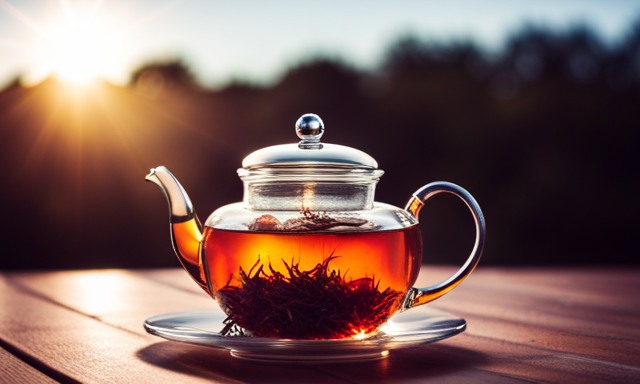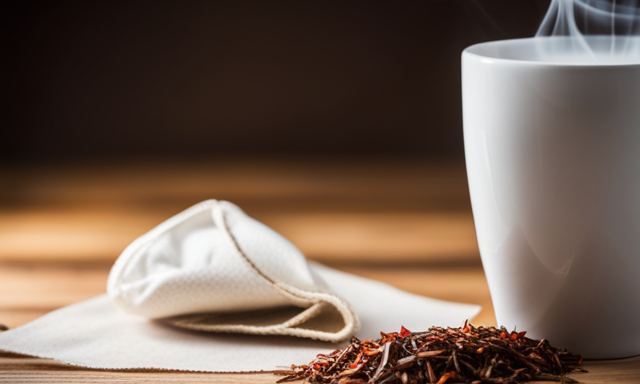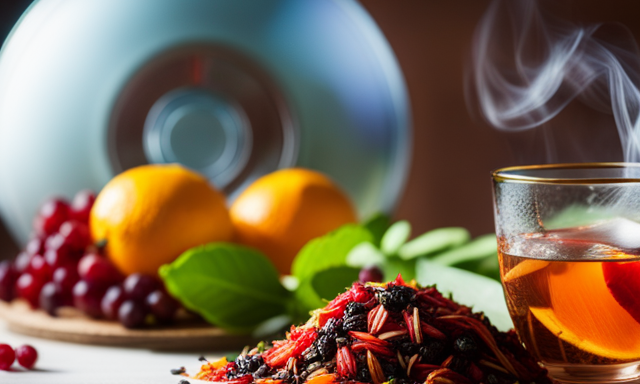Have you ever found yourself sipping on a cup of rooibos tea, waiting for that perfect balance of flavor to emerge?
It’s like standing at the edge of a serene lake, watching the ripples slowly fade away. As a passionate tea enthusiast, I understand the importance of steeping time when it comes to unlocking the full potential of rooibos tea.
That’s why I’m here to share my knowledge and expertise on how long to steep rooibos, so you can experience the true depth and complexity of this unique beverage.
In this article, I will guide you through the art of steeping rooibos tea, from understanding the different types of leaves to finding the optimal water temperature.
We will delve into the intricacies of steeping time guidelines, and I’ll even encourage you to experiment and enhance the flavor of your rooibos tea.
So, sit back, relax, and let’s embark on a journey to discover the perfect steeping time for your cup of rooibos tea.
Key Takeaways
- Rooibos tea should be steeped for 5-7 minutes for the best flavor.
- Longer steeping time enhances the richness and aroma of rooibos tea.
- Proper steeping time is essential for unlocking the full potential and satisfaction of rooibos tea.
- Experimenting with steeping time can help find the perfect balance of flavors and aromas.
Understanding Rooibos Tea
So, you’re curious about rooibos tea and want to understand all there is to know about it? Well, you’ve come to the right place. Let me shed some light on this fascinating beverage.
Rooibos tea, also known as red bush tea, is a herbal tea that originates from South Africa. It is made by steeping the leaves of the Aspalathus linearis plant. What sets rooibos tea apart from other teas is its rich, earthy flavor and its numerous health benefits.
Packed with antioxidants, this tea is known to boost the immune system, promote healthy digestion, and even help with skin conditions.
Now, let’s move on to the next section where we discuss choosing the right rooibos blend and the importance of selecting high-quality leaves.
Choosing the Right Rooibos Tea Leaves
When picking out your rooibos tea leaves, it’s important to choose the right ones that will deliver the perfect flavor and aroma to your cup. Here are four key factors to consider when selecting the ideal rooibos blend:
-
Quality: Look for high-quality, organic rooibos leaves that are carefully harvested and processed to ensure optimal taste and health benefits.
-
Flavor Profile: Consider your personal preferences. Rooibos comes in various flavors such as vanilla, citrus, or herbal blends. Choose a blend that appeals to your taste buds.
-
Health Benefits: Rooibos tea is known for its numerous health benefits, including its high antioxidant content and potential anti-inflammatory properties. Choose a blend that aligns with your wellness goals.
-
Source: Pay attention to the origin of the rooibos leaves. South African rooibos is renowned for its superior quality and unique taste.
Now that you’ve chosen the perfect rooibos blend, let’s delve into the importance of water temperature for steeping.
The Importance of Water Temperature
When it comes to steeping rooibos tea, it’s important to pay attention to the water temperature. To ensure optimal flavor extraction, the water should be heated to around 195°F (90°C). Boiling water should be avoided as it can result in a bitter taste and overpower the delicate flavors of the tea leaves.
By maintaining the right water temperature, you can enjoy a perfectly steeped cup of rooibos tea every time.
Optimal Temperature for Steeping Rooibos Tea
To get the best flavor from your rooibos tea, it’s important to steep it at the optimal temperature. Steeping rooibos tea at lower temperatures allows for longer optimal steeping time, resulting in a more flavorful and aromatic brew. The benefits of steeping at lower temperatures include a smoother and less bitter taste, as well as preserving the delicate flavors and antioxidants present in the tea leaves. To help you achieve the perfect cup of rooibos tea, refer to the table below for the recommended steeping temperatures and times.
| Temperature (°C) | Steeping Time (minutes) |
|---|---|
| 85 | 5-7 |
| 90 | 3-5 |
| 95 | 2-4 |
By steeping rooibos tea at the optimal temperature, you can enjoy a cup of tea that is full-bodied and bursting with flavor. Now, let’s move on to the next section about avoiding boiling water to further enhance your tea experience.
Avoiding Boiling Water
Steeping your tea in water that’s too hot can detract from its delicate flavors and aromas, so it’s crucial to avoid using boiling water. Rooibos tea is known for its unique taste and health benefits, and to fully appreciate its qualities, it’s important to steep it at the right temperature. Avoiding scalding water is key to achieving the perfect cup of rooibos.
Instead of using boiling water, which can be around 212 degrees Fahrenheit, it’s recommended to use water that’s around 190-200 degrees Fahrenheit. This temperature range allows the tea to steep without extracting any bitter or astringent flavors. If you don’t have a thermometer, you can simply let the water cool for a few minutes after boiling, as this’ll help achieve the optimal temperature.
Now, let’s move on to the next section and discuss the steeping time guidelines for rooibos tea.
Steeping Time Guidelines
Imagine yourself in a peaceful garden, where the gentle breeze whispers secrets through the leaves, guiding you on a journey to discover the perfect steeping time for your rooibos tea. As you prepare to indulge in this delightful brew, let me share with you some steeping techniques that’ll enhance its flavor profiles.
-
Delicate: Steep rooibos for 5-7 minutes to extract its subtle flavors, allowing them to blossom gently on your palate.
-
Bold: For a stronger brew, steep rooibos for 7-10 minutes, unlocking its robust flavors and creating a rich, full-bodied experience.
-
Intense: If you desire a more intense infusion, steep rooibos for 10-15 minutes, extracting its deep flavors and capturing its essence in every sip.
Now that you’ve mastered the art of steeping, it’s time to embark on an exciting adventure of experimenting with steeping times. Let’s delve deeper into the realm of rooibos and explore the endless possibilities that await us.
Experimenting with Steeping Times
As we explored in the previous subtopic, steeping time guidelines can vary depending on personal preference. However, it is always interesting to experiment with different steeping times to discover unique flavors and aromas. When it comes to rooibos tea, this experimentation can be particularly rewarding. Rooibos tea is known for its versatility and ability to blend well with various flavors. By adjusting the steeping time, you can bring out different notes and intensities, allowing you to create a customized cup of tea that suits your taste buds perfectly. Additionally, rooibos tea offers numerous health benefits, such as being rich in antioxidants and supporting a healthy immune system. So, not only can you enjoy the process of experimenting with steeping times, but you can also reap the rewards of a delicious and nourishing cup of tea. In the next section, I will share some tips for steeping rooibos tea to help you achieve the best results.
Tips for Steeping Rooibos Tea
To make sure you get the most out of your cup of rooibos tea, here are some helpful tips for steeping that will enhance your tea-drinking experience. First, it’s important to use freshly boiled water when steeping rooibos tea. This will ensure that the flavors are extracted properly and that you get a rich, full-bodied cup of tea.
Additionally, be sure to steep the tea for at least 5 minutes to allow the flavors to fully develop. If you prefer a stronger flavor, you can steep for a little longer, but be careful not to over-steep as it can result in a bitter taste.
After steeping, remove the tea leaves or bags promptly to prevent any bitterness from seeping into the tea.
Finally, store your rooibos tea properly in an airtight container to maintain its freshness and flavor.
By following these tips, you can enhance the flavor of your rooibos tea and enjoy a delicious cup every time.
Moving on to enhancing the flavor of rooibos tea, let’s explore some exciting options.
Enhancing the Flavor of Rooibos Tea
One way to enhance the flavor of your cup of rooibos tea is by adding a splash of honey or a squeeze of lemon for a delightful twist. Not only does this enhance the taste, but it also adds to the overall aroma of the tea.
Honey brings a subtle sweetness that complements the earthy flavors of rooibos, while lemon adds a refreshing tang. Additionally, both honey and lemon have their own health benefits, making your cup of rooibos tea even more beneficial. Honey is known for its antibacterial properties and soothing effects on the throat, while lemon is packed with vitamin C and antioxidants.
By incorporating these ingredients, you can elevate your rooibos tea experience both in terms of taste and health benefits.
Moving on to the next topic of storing rooibos tea properly…
Storing Rooibos Tea Properly
When properly stored, rooibos tea can maintain its flavor and aroma for an extended period of time. Properly storing rooibos tea is essential to preserving its freshness and ensuring a delightful tea-drinking experience.
To store rooibos tea properly, it’s important to keep it away from moisture, light, and strong odors. The best way to store rooibos tea is in an airtight container, preferably made of glass or tin, in a cool and dark place. This will help prevent the tea from absorbing any unwanted odors or moisture that can degrade its quality.
By properly storing rooibos tea, you can ensure that it remains fresh and delicious for a long time.
Now, let’s move on to the next section about enjoying rooibos tea and exploring its various flavors and health benefits.
Enjoying Rooibos Tea
Indulge yourself in the rich flavors and health benefits of rooibos tea by exploring its various blends and brewing techniques. Here are three tips for brewing the perfect cup of rooibos tea:
-
Water temperature: Heat water to around 200°F (93°C) for optimal flavor extraction. Avoid using boiling water, as it can result in a bitter taste.
-
Steeping time: Steep rooibos tea for 5-7 minutes to ensure a full-bodied flavor. Unlike other teas, rooibos doesn’t become bitter if steeped for a longer time, so feel free to adjust according to your preference.
-
Enhancements: Rooibos tea is delicious on its own, but you can also add a touch of sweetness with honey or a squeeze of lemon for a refreshing twist.
By following these tips for brewing, you can fully enjoy the health benefits and delightful taste of rooibos tea.
Now, let’s move on to answering frequently asked questions about steeping rooibos tea.
Frequently Asked Questions about Steeping Rooibos Tea
When it comes to enjoying rooibos tea, there are a few factors that can greatly enhance the experience. One of the most important aspects is the steeping time. As a tea enthusiast, I’ve experimented with various steeping times to find the perfect balance of flavors. The beauty of rooibos tea is that it’s incredibly forgiving, allowing for a range of steeping times without compromising the taste.
However, I’ve discovered that a steeping time of 5-7 minutes tends to yield the best results. This allows the flavors to fully develop and the aroma to become even more pronounced. By giving the tea a little extra time to steep, you can truly unlock the full potential of the rooibos leaves and indulge in a cup of tea that’s rich, aromatic, and utterly satisfying.
Frequently Asked Questions
Can I use boiling water to steep rooibos tea?
Boiling water is the perfect companion for steeping rooibos tea, infusing it with robust flavors. However, steeping time is crucial. To achieve the perfect balance, allow the tea to steep for 5-7 minutes.
How long can I store steeped rooibos tea before it goes bad?
Rooibos tea can be stored for up to two days before it starts to lose its flavor and freshness. After that, tea oxidation will occur, causing the taste to deteriorate.
Can I reuse rooibos tea leaves for a second steeping?
Rooibos tea leaves can be reused for a second steeping, resulting in a satisfying and sustainable tea experience. Steeping time may need to be slightly extended to extract the full flavor potential.
Can I add sweeteners like honey or sugar while steeping rooibos tea?
Yes, you can definitely add sweeteners like honey or sugar while steeping rooibos tea. It not only enhances the flavor but also offers additional benefits such as soothing a sore throat and providing antioxidants.
Does the quality of the water affect the taste of steeped rooibos tea?
The quality of the water greatly affects the taste of steeped rooibos tea. Using water that is too hot can result in a bitter taste, while water that is too cold may not extract the flavors properly. Finding the optimal water temperature and steeping time is essential for a perfect cup.
Conclusion
In conclusion, steeping rooibos tea requires attention to detail and a dash of patience. By understanding the characteristics of rooibos tea and selecting the right leaves, we can ensure a delightful cup of tea.
The importance of water temperature can’t be overlooked, as it directly impacts the flavor profile. Following the recommended steeping times will result in a perfectly balanced brew, but don’t be afraid to experiment and find your preferred strength.
Remember, the proof is in the pudding, or in this case, the tea cup. So go ahead, savor the rich flavors of properly steeped rooibos tea and let it transport you to a world of relaxation and indulgence.










